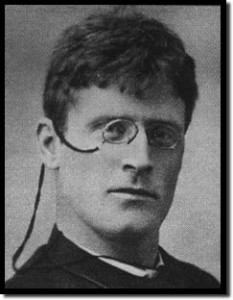Remembering Knut Hamsun
(August 4, 1859–February 19, 1952)
Greg Johnson
Knut Hamsun was born Knut Pedersen in Lom, Norway on August 4, 1859. He died in Grimstad, Norway, on February 19, 1952. The author of more than twenty novels, plus poems, short stories, plays, and essays, Hamsun was one of the twentieth century’s most influential writers. His rejection of both Romanticism and naturalism, his emphasis on outsiders and rebels, and his exploration of inner and sometimes extreme states of consciousness, made him a pioneer of literary modernism. He received the Nobel Prize for literature in 1920.
Indifferent to religion, Hamsun was most deeply influenced by Nietzsche, as well as by Dostoevsky and Strindberg. Hamsun rejected both Communism and capitalism, emphasizing agrarian and ecological values. With the rise of National Socialism in Germany, he at last found a political movement that reflected his own worldview. After the Second World War, Hamsun, his wife Marie, and his son Arild (who had joined the Waffen SS) were imprisoned by the Norwegian government.
We have published one piece by Hamsun, a previously untranslated letter opposing socialism and pacifism that was written during the First World War and later published in a Norwegian National Socialist journal during the Second World War: “Knut Hamsun Against the Socialists.”
Additionally, I wish to draw your attention to the following writings about Hamsun on this website:
- Alain de Benoist, “Knut Hamsun“
- Kerry Bolton, “Knut Hamsun“
- Mark Deavin, “Knut Hamsun and the Cause of Europe“
- Spencer J. Quinn, “Knut Hamsun’s Growth of the Soil“
- Spencer J. Quinn, “Knut Hamsun’s Hunger“
- Quintilian, “Knut Hamsun’s Pan“
- Robert Steuckers, “Paganism and Vitalism in Knut Hamsun and D. H. Lawrence,” Part 1, Part 2
- Anonymous, “Knut Hamsun: Saved by Stalin?“
 Hamsun’s Growth of the Soil (1917) is his longest but most accessible novel; it won him the Nobel Prize. Hamsun’s breakthrough novel is Hunger (1890), which is one of the most unsettling books I have ever read — up there with Mishima’s best work. Other highly recommended shorter, early novels are Mysteries (1892) and Pan: From Lieutenant Thomas Glahn’s Papers (1894).
Hamsun’s Growth of the Soil (1917) is his longest but most accessible novel; it won him the Nobel Prize. Hamsun’s breakthrough novel is Hunger (1890), which is one of the most unsettling books I have ever read — up there with Mishima’s best work. Other highly recommended shorter, early novels are Mysteries (1892) and Pan: From Lieutenant Thomas Glahn’s Papers (1894).
As a young man, Hamsun spent four years in the United States, which gave him an abiding distaste for Anglo-Saxon culture and capitalism — convictions that were hardened during the Second Boer War. See Knut Hamsun Remembers America: Essays and Stories, 1885–1949, ed. and trans. Richard Nelson Current (Columbia: University of Missouri Press, 2003).
For a biography of Hamsun, I highly recommend Robert Ferguson, Enigma: The Life of Knut Hamsun (New York: Farrar Straus Giroux, 1987). I have not read Ingar Slettin Koloen’s Knut Hamsun: Dreamer & Dissenter (New Haven: Yale University Press, 2009), but it is supposed to be definitive. Finally, I highly recommend Swedish director Jan Troell’s 1996 biopic Hamsun, starring Max von Sydow as Hamsun.
* * *
Counter-Currents has extended special privileges to those who donate $120 or more per year.
- First, donor comments will appear immediately instead of waiting in a moderation queue. (People who abuse this privilege will lose it.)
- Second, donors will have immediate access to all Counter-Currents posts. Non-donors will find that one post a day, five posts a week will be behind a “paywall” and will be available to the general public after 30 days.
To get full access to all content behind the paywall, sign up here:
Remembering%20Knut%20Hamsun%20%28August%204%2C%201859and%238211%3BFebruary%2019%2C%201952%29
Enjoyed this article?
Be the first to leave a tip in the jar!
Related
-
Nowej Prawicy przeciw Starej Prawicy, Rozdział 3: Metapolityka i wojna tajemna
-
Counter-Currents Radio Podcast No. 583: Judd Blevins on His Recall and Pro-White Politics
-
Remembering Sam Francis (April 29, 1947–February 15, 2005)
-
Nowej Prawicy przeciw Starej Prawicy, Rozdział 2: Hegemonia
-
Nowej Prawicy przeciw Starej Prawicy, Rozdział 1: Nowa Prawica przeciw Starej Prawicy
-
Nowej Prawicy przeciw Starej Prawicy: Wprowadzenie
-
Nowej Prawicy przeciw Starej Prawicy: Przedmowa
-
Notes on Plato’s Alcibiades I Part 2

2 comments
There is a movie version of “Mysteries” from 1979 starring Rutger Hauer and Sylvia Kristel (of Emmanuelle fame).
It appears to have been poorly received.
The movie for Mysteries is not bad, it is interesting in that it was filmed on the Faroe Islands and stars Rutger Hauer as Johan Nagel. It’s more than you would typically expect from a film adaptation of a Hamsun novel, which are not exactly Hollywood productions. I would say it should only be watched for fun after reading the book, which is probably my favourite of Hamsun’s.
Besides the movie, there is a tone poem for Hamsun’s Mysteries written by Paul Juon, who was once a very popular composer, and that is worth listening to. You can find it on youtube: https://youtu.be/4-SEUEZDfgI
Comments are closed.
If you have Paywall access,
simply login first to see your comment auto-approved.
Note on comments privacy & moderation
Your email is never published nor shared.
Comments are moderated. If you don't see your comment, please be patient. If approved, it will appear here soon. Do not post your comment a second time.